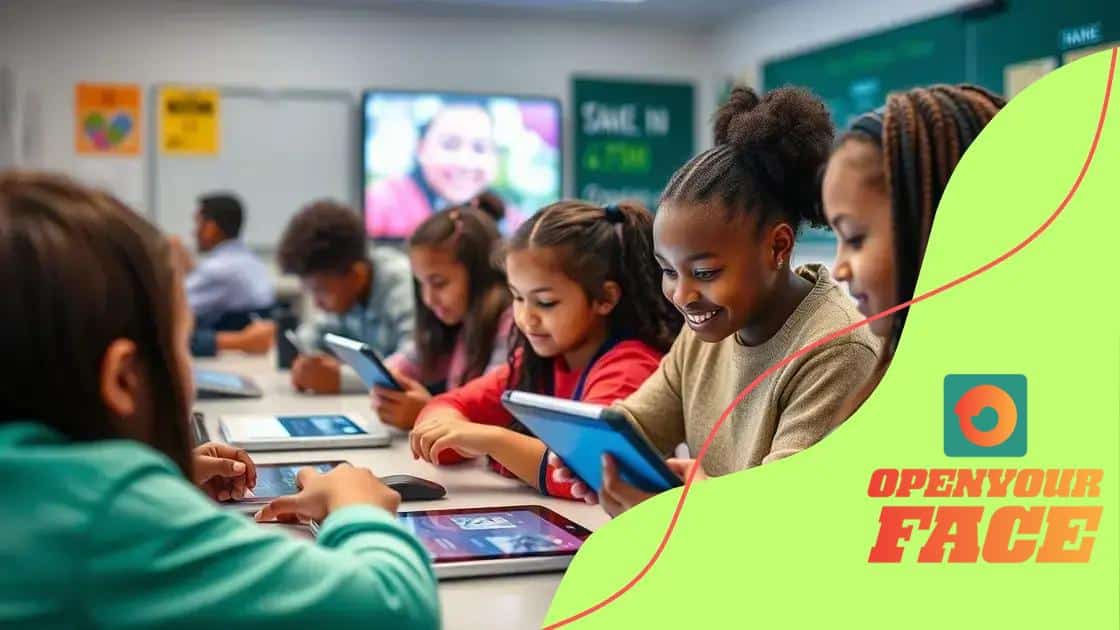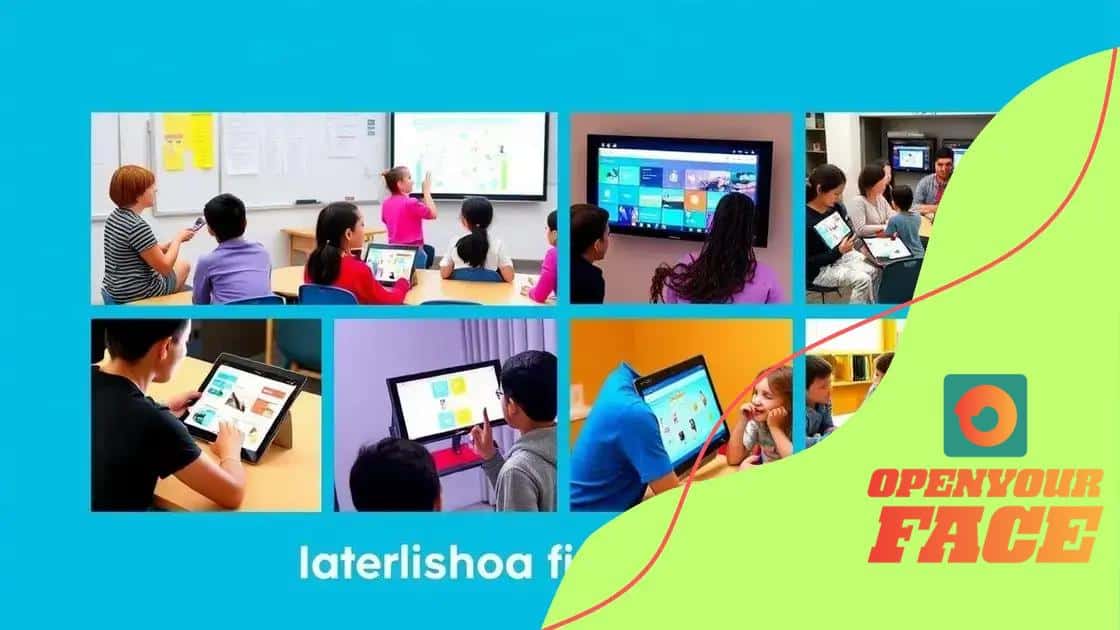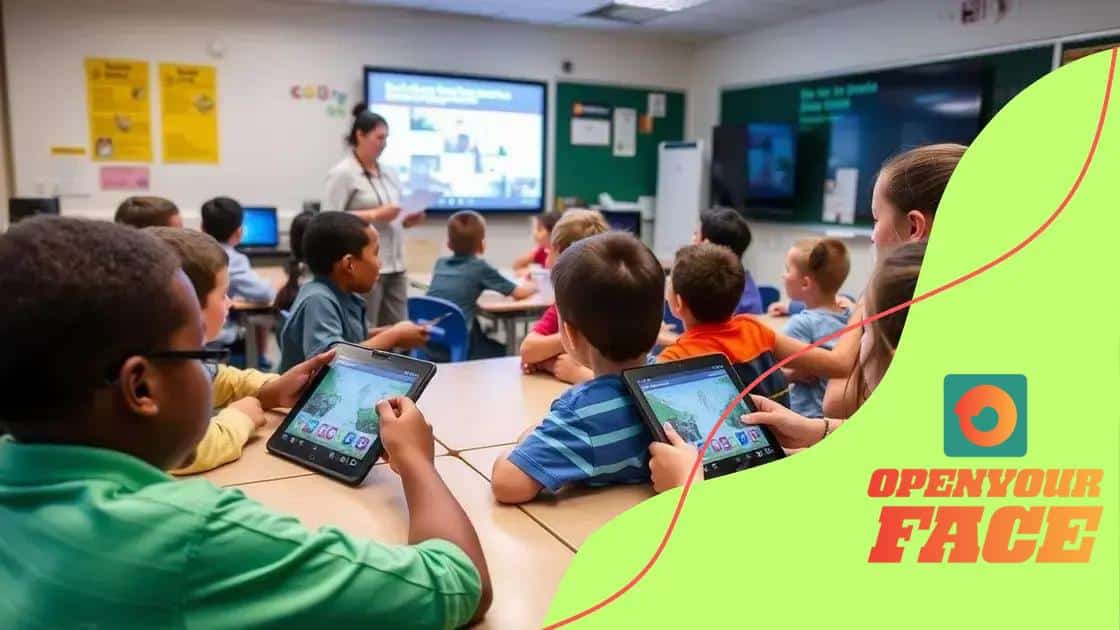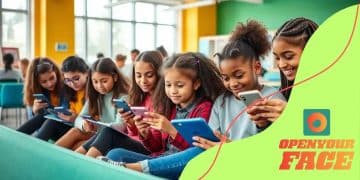How to improve student engagement through interactive media

To improve student engagement through interactive media, educators should integrate tools like educational games and virtual reality, gather regular feedback, and regularly assess effectiveness to create a dynamic learning environment.
How to improve student engagement through interactive media is a question many educators are asking. With technology shaping learning environments, interactive media can be a game changer. Have you considered how these tools might energize your classroom experience?
Understanding the role of interactive media
Understanding the role of interactive media in education is essential for enhancing student participation. In today’s digital age, these tools offer unique ways to connect with learners. By leveraging technology, educators can create immersive experiences that captivate students and stimulate their interest.
Interactive media includes various elements, such as videos, games, and simulations. These resources can transform conventional teaching methods. They not only engage students on a deeper level but also cater to different learning styles.
Benefits of Interactive Media
There are numerous benefits of using interactive media in the classroom. Let’s explore some key advantages:
- Enhances student engagement and motivation.
- Promotes active learning through participation.
- Encourages collaboration among students.
- Provides immediate feedback to learners.
When students interact with tailored content, they are more likely to absorb information. This active involvement can lead to better understanding and retention. For instance, a science simulation can illustrate complex concepts in a tangible way.
Moreover, these tools can help bridge the gap between theory and practice. Students who engage with interactive media often find real-world connections to their studies. This relevance can foster a passion for learning, inspiring them to pursue knowledge further.
Examples of Interactive Media
Incorporating different forms of interactive media can make curriculum delivery more exciting:
- Educational games that reinforce subject matter.
- Videos that offer visual demonstrations.
- Online quizzes that help assess knowledge.
Utilizing these resources invites students to participate actively in their learning journey. As they navigate through multimedia, they can explore topics at their own pace.
In summary, understanding the role of interactive media in education helps educators create engaging environments. These dynamic tools not only attract student interest but also promote a deeper understanding of the material. As technology evolves, so do the opportunities to enrich the current educational landscape.
Benefits of interactive media for student engagement

Benefits of interactive media for student engagement are numerous and impactful. These tools not only make learning fun but also enhance comprehension and retention. Engaging students through media they love can create a more dynamic classroom atmosphere.
Interactive media encourages active participation, which is vital for effective learning. When students interact with content, they are more likely to stay focused and absorbed. This participation can lead to a deeper understanding of subjects, as they are no longer passive recipients of information.
Key Advantages of Interactive Media
Here are some key advantages of using interactive media to boost engagement:
- Increases motivation by making learning enjoyable.
- Caters to diverse learning styles, accommodating visual, auditory, and kinesthetic learners.
- Fosters collaboration through group activities and discussions.
- Offers instant feedback, allowing students to track their progress.
By integrating these benefits into lessons, teachers can create an inclusive learning environment. For example, using games can appeal to students who may be less engaged with traditional methods. Interactive media provides opportunities for students to experiment with concepts in a safe setting.
Furthermore, it can facilitate critical thinking skills. Projects that require students to create content or solve problems can help develop their analytical abilities. Students learn to think creatively and approach challenges from various angles, preparing them for real-world situations.
Long-Term Impact on Learning
The long-term impact of interactive media on learning can be profound. Research indicates that students who regularly engage with interactive tools often perform better in assessments. Their improved retention rates are due to the multi-sensory experiences these tools provide.
In summary, the benefits of interactive media for student engagement extend far beyond the classroom. They help cultivate a love for learning that can last a lifetime. By making lessons more captivating and relevant, educators can ensure that students are not just learning but thriving.
Popular types of interactive media
Popular types of interactive media play a crucial role in engaging students and enhancing their learning experience. These tools come in various formats, each providing unique benefits. Understanding these types can help educators choose the best options for their classrooms.
One popular type is educational games. These games encourage students to think critically while having fun. They often incorporate challenges and levels that motivate students to progress. Additionally, they can cover subjects like math, science, and language arts.
Virtual Reality and Augmented Reality
Another exciting category is virtual reality (VR) and augmented reality (AR). These technologies allow students to explore immersive environments. For instance, a VR module can transport students to historical events or distant planets. It engages their imagination and curiosity.
- Virtual tours of museums and landmarks.
- Augmented reality apps that bring static images to life.
- Simulation games that replicate real-world scenarios.
These experiences can make complex topics more accessible. For example, biology students can dissect virtual frogs, gaining hands-on practice without the mess.
Interactive Videos and Multimedia Presentations
Interactive videos are yet another effective type of interactive media. These videos allow students to make choices that affect the course of the content. This feature enhances engagement and helps develop decision-making skills.
Multimedia presentations are also popular, combining text, images, and audio. They cater to various learning styles and keep students interested. Teachers can create their presentations using tools like PowerPoint or Prezi, adding elements like quizzes and discussions.
Another noteworthy type is educational podcasts. These audio resources can provide insights into various topics. They are ideal for auditory learners and can be listened to anywhere, allowing for flexibility in learning.
In summary, the popular types of interactive media offer diverse ways to engage students. By incorporating these tools, educators can make learning more dynamic and enjoyable, ultimately fostering a deeper understanding of the material.
Best practices for implementation in classrooms

Best practices for implementation of interactive media in classrooms can significantly enhance student engagement. To ensure these tools are effective, teachers should consider various strategies. Proper planning and execution are vital for maximizing the benefits of technology in education.
Planning and Preparation
Before integrating interactive media, it’s essential to have a clear plan. Start by identifying specific learning outcomes you wish to achieve. Establish how technology can support these goals. Additionally, consider the diverse needs of your students, ensuring that every learner is included.
- Assess available resources and technology.
- Determine which types of interactive media align with your curriculum.
- Prepare training for both teachers and students on using these tools.
By having a systematic approach, educators can increase the chances of success when implementing new media in the classroom.
Engaging Students Actively
Engagement is key when it comes to interactive media. Encourage students to participate actively in their learning. This can be done by allowing them to make choices in their learning process, such as selecting topics or the format of projects.
Incorporate team activities where students can collaborate. Group projects not only promote teamwork but also help students learn from one another. This kind of interaction fosters a sense of community and makes learning more enjoyable.
Monitor and Adjust
After implementation, it’s vital to monitor students’ progress. Regularly assess how well students are engaging with the interactive media used. Gather feedback from students about their experiences. This information can help you make adjustments to improve the learning environment.
It’s also crucial to evaluate whether the media is meeting the intended learning outcomes. If not, be ready to adapt your approach. Continuous improvement is at the heart of effectively utilizing technology in education.
Measuring effectiveness and feedback
Measuring effectiveness and feedback is essential when integrating interactive media in classrooms. It helps educators understand what is working and what needs improvement. By actively seeking feedback, teachers can fine-tune their teaching strategies to enhance student engagement.
One effective method for measuring engagement is through assessments. Regular quizzes or surveys can provide insights into how well students are grasping the material. Additionally, these assessments can help identify areas where students are struggling. This information is valuable for adjusting lesson plans accordingly.
Gathering Student Feedback
Gathering feedback directly from students is another crucial aspect. Encourage them to share their thoughts on the interactive media used in class. This can be done through simple feedback forms or classroom discussions.
- Ask what they enjoyed most about the interactive tools.
- Inquire about any difficulties they faced.
- Encourage suggestions for improvement.
Listening to students can provide valuable insights and help educators make informed decisions. Their perspectives can highlight what captures their interest and what doesn’t.
Analyzing Data and Observations
In addition to getting feedback, analyzing data is important. Look at participation rates during lessons with interactive media. Observe how engaged students are—are they actively participating or simply going through the motions?
Tracking attendance and performance can also reveal trends over time. For instance, if students show improved test scores after using a particular tool, it may indicate its effectiveness. Furthermore, looking for patterns in data can help identify which types of media resonate best with students.
In conclusion, measuring effectiveness and feedback regarding interactive media is vital for enhancing the educational experience. By adopting a systematic approach to gather data and insights, educators can create dynamic learning environments that foster student success.
FAQ – Frequently Asked Questions about Interactive Media in Education
How does interactive media improve student engagement?
Interactive media captivates students by making learning fun and immersive, encouraging active participation in the learning process.
What are some popular types of interactive media used in classrooms?
Common types include educational games, virtual reality experiences, interactive videos, and multimedia presentations.
How can educators measure the effectiveness of interactive media?
Educators can track student performance, participation rates, and collect feedback to assess how well interactive media supports learning goals.
Why is gathering feedback crucial in implementing interactive media?
Feedback from students helps educators understand their experiences, allowing for adjustments that enhance engagement and learning outcomes.






